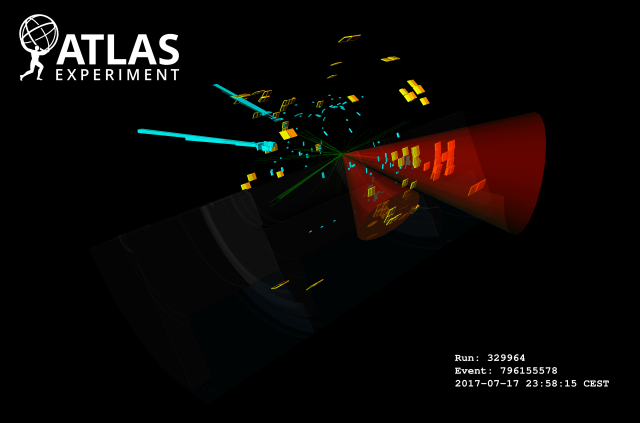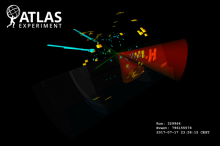New measurement of the Higgs boson self-coupling
The ATLAS-LAPP group participated in the measurement of Higgs boson self-coupling with Run 2 data in the “golden” HH→bbyy decay channel. The measurement, which is the most accurate to date, was just presented at the Moriond QCD 2021 conference.
Since the discovery of the Higgs boson in 2012, a priority of the ATLAS and CMS collaborations has been to better understand its properties and measure its coupling to bosons and fermions. Most of these couplings have already been observed at the end of Run-2 (2015-2018). Observing the coupling of the Higgs boson with itself (self-coupling) is the principal objective of the LHC program. Measuring this coupling will give access to the potential shape of the Higgs field, which might allow us to know if there are new particles that disturb this field. The production of two Higgs bosons in the same proton-proton collision (HH) is the only direct way to measure this self-coupling denoted 𝞳𝝺. HH events are 1000 times rarer than the production of a single Higgs boson, which explains why this production has not been observed to date.
Since 2016, the ATLAS-LAPP group has focused on the “gold” decay channel H (→bb) H (→𝛾𝛾) for this research because of its high background rejection factor and despite a small connection ratio (0.3%).

As part of Mohamed Belfkir’s thesis, new ideas have been implemented to improve particle reconstruction precision and the separation between signal (HH) and background. Their integration with other analysis techniques applied to all the Run 2 data (2015-2018) improves analysis sensitivity by a factor of 5, of which 2.6 through improved analysis techniques and 3.4 through the increase in the number of recorded collisions.
No significant H (→ bb) H (→ 𝛾𝛾) signal was observed in the Run 2 data, this results in a limit on the cross-section of 140 fb compared to the 33 fb predicted by the Standard Model framework. The presence of new physics beyond the Standard Model could enhance this cross-section, leading to the observation of this type of event. The measured Higgs self-coupling is in the interval [-1.5; 6.7] @ 95% C.L, which covers the value of the Standard Model (𝞳𝝺 = 1). To date, the H (→ bb) H (→ 𝛾𝛾) channel provides the best measurement of this parameter. This measurement will be improved by combining them with other HH decay channels (bbbb, bb𝜏𝜏, …) that are being finalized.
With the increase in the number of recorded collisions by Run 3 (factor 3), the accuracy of the measurements will improve significantly and offer the possibility of studying other production methods. If the HH production rate corresponds to the one predicted by the Standard Model, its observation will be achieved only with the full dataset collected at the High Luminosity LHC program (2027 – 2038). A significance of 4 sigma is expected by combining all decay channels and a precision of 50% for 𝞳𝝺 (Estimation from the last European Strategy Forum).
Contacts: M. Belfkir, S. Jezequel, N. Berger
More information:
- ATLAS briefing : https://atlas.cern/updates/briefing…
- ATLAS briefing video :
- https://twitter.com/ATLASexperiment…
- ATLAS Conf Note : https://atlas.web.cern.ch/Atlas/GRO…
- Moriond QCD talk: http://moriond.in2p3.fr/QCD/2021/Su…
- Group web page : Double Higgs production : https://lapp.in2p3.fr/spip.php?arti…
Lorem ipsum dolor sit amet, consectetur adipiscing elit. Ut elit tellus, luctus nec ullamcorper mattis, pulvinar dapibus leo.


